四年级下册英语教案-Unit 4 At the farm Part A Let's talk Let's play 人教(PEP)
大单元单元整体教学设计英语四下第四单元
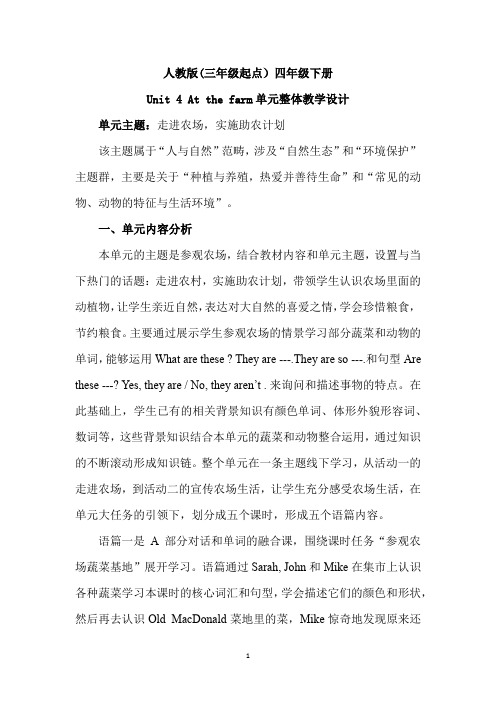
人教版(三年级起点)四年级下册Unit 4 At the farm单元整体教学设计单元主题:走进农场,实施助农计划该主题属于“人与自然”范畴,涉及“自然生态”和“环境保护”主题群,主要是关于“种植与养殖,热爱并善待生命”和“常见的动物、动物的特征与生活环境”。
一、单元内容分析本单元的主题是参观农场,结合教材内容和单元主题,设置与当下热门的话题:走进农村,实施助农计划,带领学生认识农场里面的动植物,让学生亲近自然,表达对大自然的喜爱之情,学会珍惜粮食,节约粮食。
主要通过展示学生参观农场的情景学习部分蔬菜和动物的单词,能够运用What are these ? They are ---.They are so ---.和句型Are these ---? Yes, they are / No, they aren’t .来询问和描述事物的特点。
在此基础上,学生已有的相关背景知识有颜色单词、体形外貌形容词、数词等,这些背景知识结合本单元的蔬菜和动物整合运用,通过知识的不断滚动形成知识链。
整个单元在一条主题线下学习,从活动一的走进农场,到活动二的宣传农场生活,让学生充分感受农场生活,在单元大任务的引领下,划分成五个课时,形成五个语篇内容。
语篇一是A部分对话和单词的融合课,围绕课时任务“参观农场蔬菜基地”展开学习。
语篇通过Sarah, John和Mike在集市上认识各种蔬菜学习本课时的核心词汇和句型,学会描述它们的颜色和形状,然后再去认识Old MacDonald菜地里的菜,Mike惊奇地发现原来还有黄色的西红柿,而且它们尝起来还不错,最后帮助Old MacDonald 把他的蔬菜卖到市场上,介绍蔬菜,学会珍惜粮食,热爱生活。
语篇二是B部分Talk和Learn的融合课例,围绕课时任务“参观农场动物乐园”展开学习。
语篇通过Mike和Sarah继续跟着Old MacDonald在农场上认识动物学习本课时核心词汇和句型,学会描述动物特征和数量。
英语四年级下册Unit4PartA 教案
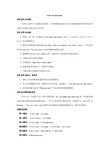
Unit 4 At the farm【单元学习内容】本单元主要学习主题是参观农场。
主情景图通过展示学生们参观农场的情景呈现本单元要学习的部分核心词汇和句型。
【单元学习目标】1. 能听、说、读、写horses, cows, hens, pig, sheep,tomato, cucumber, potato, onion, carrot及其复数形式。
2. 能在实际情境中运用What are they? They are tomatoes. Are these / those … ?”及其答语“Yes, they are. / No, they aren’t.”询问动物和蔬菜的名称。
3. 能理解Let’s do / Let’s chant内容,并能发出与农场相关的简单指令。
4. 了解or组合的发音规律。
5. 学唱歌曲“Mary Has a Little Lamb”。
6. 能够填充短语或句子,做到书写规范。
7. 了解几条与动物相关的英语习语。
【单元学习重点、难点】1.农场上常见的牲畜和蔬菜名称及其复数形式。
2.包含名词复数形式的一般疑问句及其回答:Are they …? Yes, they are. No, they aren’t.3.在实际情境中运用“What are they?”询问动物和蔬菜的数量。
【单元内容学情分析】学生已在三年级学习过一部分动物名称,如:cat, rabbit, pig, duck, dog等,可把教学重点放在新出现的动物和蔬菜名称上。
学生已经会用单数形式的一般疑问句及其回答Is this/that…?Yes,it is. No, it isn’t.教师可从单数形式过渡到复数形式,两者对比教学。
【课时安排】第一课时:A Let’s talk Let’s play第二课时:A Let’s Learn Let’s chant第三课时:A Let’s spell C Pronunciation第四课时:B Let’s talk Let’s play C Let’s sing Let’s check第五课时:B Let’s learn draw and say C Story time第六课时:B Read and write第一课时A Let’s talk Let’s play【学习内容】学习句型What are these?及其答语:They are tomatoes.和Are these … ?及其答语“Yes, they are. / No, they aren’t.”【教材分析】本部分学生学习的核心句型是:Are these carrots?及其答语“Yes, they are. / No, they aren’t.” 及What are these? They are tomatoes.教材通过Mike 与Amy参观农场并与农场主人对话的情景让学生感知上述句型的语义及语用情景。
人教PEP版英语四年级下册Unit 4《At the farmt》(read, listen and

人教PEP版英语四年级下册Unit 4《At the farmt》(read, listen and numberPartA)教案一. 教材分析《At the farm》是人教PEP版英语四年级下册Unit 4的教学内容,主要通过描述农场中的动物和颜色,让学生进一步学习一般现在时态和基数词。
本节课的主要语言目标是让学生能够听懂、会说、会读和会写关于农场动物和颜色的词汇,同时能够运用一般现在时态描述农场中的动物。
二. 学情分析四年级的学生已经掌握了基本的英语语音、词汇和简单的句子结构,具备了一定的听、说、读、写的能力。
他们对新鲜事物充满好奇,接受能力强,但同时注意力容易分散。
因此,在教学过程中,需要通过丰富的教学活动和趣味性的内容来吸引他们的注意力,激发他们的学习兴趣。
三. 教学目标1.知识目标:学生能够听懂、会说、会读和会写关于农场动物和颜色的词汇,如cow, pig, hen, horse, white, black, yellow等。
2.能力目标:学生能够运用一般现在时态描述农场中的动物。
3.情感目标:培养学生热爱生活,关注大自然的情怀。
四. 教学重难点1.重点:学生能够听懂、会说、会读和会写关于农场动物和颜色的词汇,并能够运用一般现在时态描述农场中的动物。
2.难点:一般现在时态的运用和农场动物颜色词汇的掌握。
五. 教学方法1.任务型教学法:通过设定各种任务,让学生在完成任务的过程中运用所学知识,提高实际运用能力。
2.情境教学法:创设真实的农场情境,让学生在情境中学习、操练和应用语言。
3.游戏教学法:通过各种游戏活动,激发学生的学习兴趣,提高课堂参与度。
六. 教学准备1.教师准备:准备好农场动物和颜色的小卡片,制作PPT,准备录音机和磁带。
2.学生准备:提前预习课文,熟悉农场动物和颜色的词汇。
七. 教学过程1.导入(5分钟)教师通过播放农场动物的叫声,引导学生谈论农场动物。
然后出示颜色词汇卡片,让学生猜测并说出颜色。
小学英语Unit 4 At the farm Part A Let's talk优质教案、教学设计
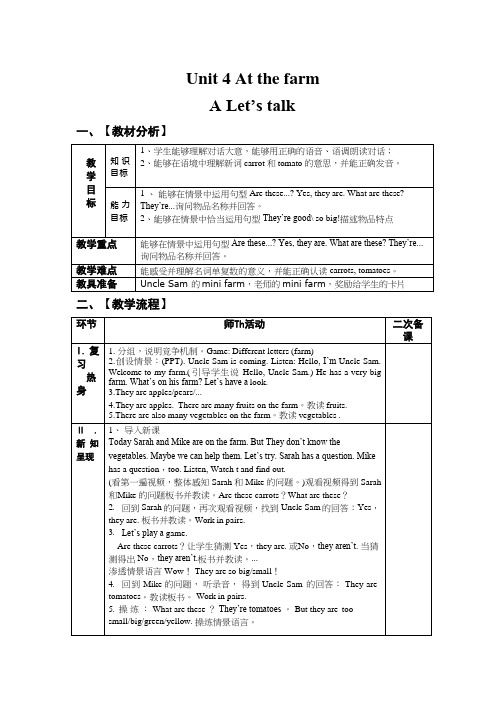
一、【教材分析】Unit 4 At the farmA Let’s talk二、【教学流程】They’re . 6.Share tomatoes. 学习练习情景语言---I have some tomatoes. Try some. They’re good.---Thanks. Yum.Ⅲ. 巩固练习 1. Listen and imitate 听音正音。
2. Read and act in groups.小组内读并表演对话,教师指导。
3.Act it out the dialogue.师生示范,生生练习4.Uncle Sam has a big farm. He has a mini farm, too. There are A,B,C,D four lands here. Look at land A, What’s on it? Let’s guess. You can ask me ---Are these...? S1 : ---Are these ... ? T:---No. they aren’t. S2 : ---Are these... ? T:---No, they aren’t. T:Never mind. You can ask me ---What are these ?(AB 师生对话 CD 生生对话)Ⅳ. 输出运用 1. I have a mini farm ,too. Hello ,welcome to my farm. What’s on my farm ?What are these ?They’re grapes/potatoes/tomatoes/carrots.(通过观察植物的茎叶,猜测植物)Now ,Let’s make a new dialogue. Youcan choose one star or two stars. And you can use the words here. Who wants to visit my farm? (师生示范)2. Design your farms. You can use the pictures you get to design your farms.3. Show your farms.Ⅴ . 检测提升 1. L et’s know more farms. (PPT 翻书,情感升华,认识现代农场 及更多的植物)2. H omework(1) Read the dialogue three times with your classmates(2)Talk about your farms after class.三、【板书设计】.Unit 4 At the farm A Let’s talkYes, they are.No, they aren’t.What are these?。
小学四年级英语下册《Unit4Atthefarm》教案
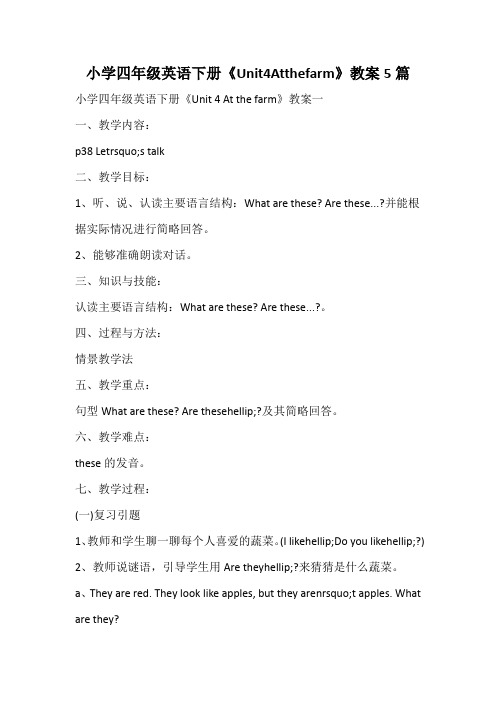
小学四年级英语下册《Unit4Atthefarm》教案5篇小学四年级英语下册《Unit 4 At the farm》教案一一、教学内容:p38 Letrsquo;s talk二、教学目标:1、听、说、认读主要语言结构:What are these? Are these...?并能根据实际情况进行简略回答。
2、能够准确朗读对话。
三、知识与技能:认读主要语言结构:What are these? Are these...?。
四、过程与方法:情景教学法五、教学重点:句型What are these? Are thesehellip;?及其简略回答。
六、教学难点:these的发音。
七、教学过程:(一)复习引题1、教师和学生聊一聊每个人喜爱的蔬菜。
(I likehellip;Do you likehellip;?)2、教师说谜语,引导学生用Are theyhellip;?来猜猜是什么蔬菜。
a、They are red. They look like apples, but they arenrsquo;t apples. What are they?b、They are tender and green. What are they?c、They are long and orange. Rabbits like eating them. What are they?学生猜对了,教师回答Yes,they are.并拿出相应的单词卡片请学生拼读;? 如果猜错了,教师回答No, they arenrsquo;t. 再请其他人猜, 直到猜对为止。
(二)教学新课1、教师请学生将装有蔬菜卡片的盒子盖好放在桌子上,然后走到同学们中间,随意指着几个盒子问:Are thesehellip;?,并引导学生根据实际用Yes, they are. / No, they arenrsquo;t.回答。
如果学生回答的是No, they arenrsquo;t. 教师要继续问:What are these?并引导学生用They are hellip;回答。
人教PEP版英语四年级下册Unit4《Atthefarmt》(Atthefarm)说课稿

人教PEP版英语四年级下册Unit 4《At the farmt》(At the farm)说课稿一. 教材分析《人教PEP版英语四年级下册Unit 4 At the farm》是一篇以农场为主题的学习单元。
本单元主要通过介绍农场中的动物和颜色,让学生掌握有关动物和颜色的基本词汇,同时学习一般疑问句和回答。
教材内容丰富,插图生动有趣,激发学生的学习兴趣。
二. 学情分析四年级的学生已经具备了一定的英语基础,能够听、说、读、写一些简单的单词和句子。
但是对于动物和颜色的词汇,部分学生可能还比较陌生。
此外,学生的学习兴趣和积极性需要被激发和保持。
三. 说教学目标1.知识目标:学生能够掌握农场动物和颜色的词汇,如cow, horse, pig,hen, tractor, white, black, yellow等。
2.能力目标:学生能够用英语简单描述农场中的动物和颜色。
3.情感目标:培养学生热爱大自然,关注动物的情感。
四. 说教学重难点1.重点:农场动物和颜色的词汇,以及一般疑问句和回答。
2.难点:一般疑问句的构成和运用,以及颜色词汇的搭配。
五. 说教学方法与手段1.教学方法:采用情境教学法、游戏教学法和交际教学法,让学生在轻松愉快的氛围中学习英语。
2.教学手段:利用多媒体课件、图片、实物等辅助教学,提高学生的学习兴趣和参与度。
六. 说教学过程1.热身(5分钟):通过唱英文歌曲《Old MacDonald Had a Farm》激发学生的学习兴趣,复习 farm 相关的词汇。
2.引入(10分钟):展示农场图片,引导学生说出他们认识的动物和颜色。
3.新课呈现(15分钟):通过多媒体课件,展示农场动物和颜色的词汇,引导学生跟读和学习。
4.练习(10分钟):分组进行角色扮演,让学生用英语描述农场中的动物和颜色。
5.巩固(5分钟):玩“找出不同”的游戏,让学生在游戏中运用所学知识。
6.总结(5分钟):对本节课所学内容进行总结,强调一般疑问句的构成和颜色词汇的搭配。
Unit4AtthefarmALet’slearn(教学设计)-人教PEP版英语四年级下册

教学环节
教师活动
学生活动
设计意图
导入新课
1.Let’s chant:Old Macdonald had a farm.
播放歌曲视频,师生同唱
Amy,John and Mike:Let’s go!
边听边唱
说一说
复习旧知,为学生学习新知及语言的输出做铺垫。
讲授新课
Vegetables farm
1.John:What are these(这些)?
——They are______.
7.Let’s guess
Are these _____源自 ?Yes, they are.或No, they aren’t.
They are ________.
8.Let’s watch.
观察图片
听音
跟读
操练
对话练习
说一说
练习
猜一猜
看视频
学生带着问题,进行了分步的有意义的视听,并在情景中对核心句型进行了认读、练习、和迁移的练习,让学生真正能够理解、学习、操练运用此语言点。
Farmer:They are potatoes.
John:Are these potatoes?
Farmer:No,they aren‘t.
2.They are tomatoes.
3.Practice
Look at these tomatoes.
They are _____.
What are these?
potato potatoes carrot carrots
Look at the …
They are so ….
(二)思维能力目标
能够灵活的描述一种蔬菜、植物的特征的句型。
四年级下册英语教案《Unit4AtthefarmpartAlet'stalk》人教pep
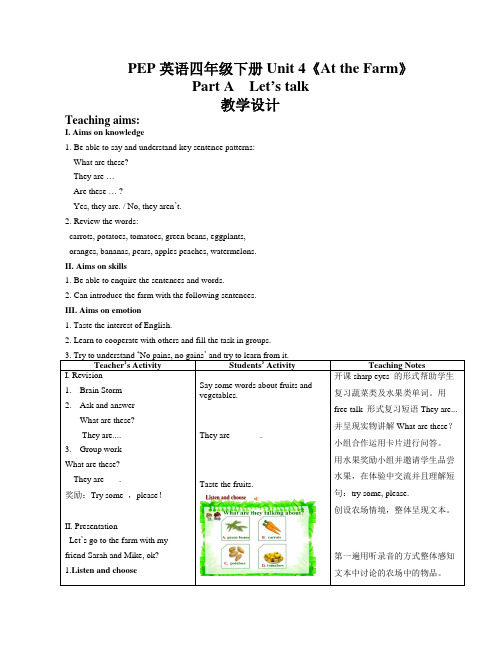
PEP英语四年级下册Unit 4《At the Farm》Part A Let’s talk教学设计Teaching aims:I. Aims on knowledge1.Be able to say and understand key sentence patterns:What are these?They are …Are these … ?Yes, they are. / No, they aren’t.2.Review the words:carrots, potatoes, tomatoes, green beans, eggplants,oranges, bananas, pears, apples peaches, watermelons.II. Aims on skills1.Be able to enquire the sentences and words.2.Can introduce the farm with the following sentences.III. Aims on emotion1. Taste the interest of English.2.Learn to cooperate with others and fill the task in groups.3. Try to understand ‘No pains, no gains’ and try to learn from it.Teacher’s Activity Students’ Activity Teaching Notes I. Revision1.Brain Storm2.Ask and answerWhat are these?They are....3.Group workWhat are these?They are ___.奖励:Try some ,please!II. PresentationLet’s go to the farm with my friend Sarah and Mike, ok?1.Listen and choose Say some words about fruits andvegetables.They are_______.Taste the fruits.开课sharp eyes 的形式帮助学生复习蔬菜类及水果类单词。
Unit 4 At the farm Part A Let's talk(教学设计)人教PEP版英语
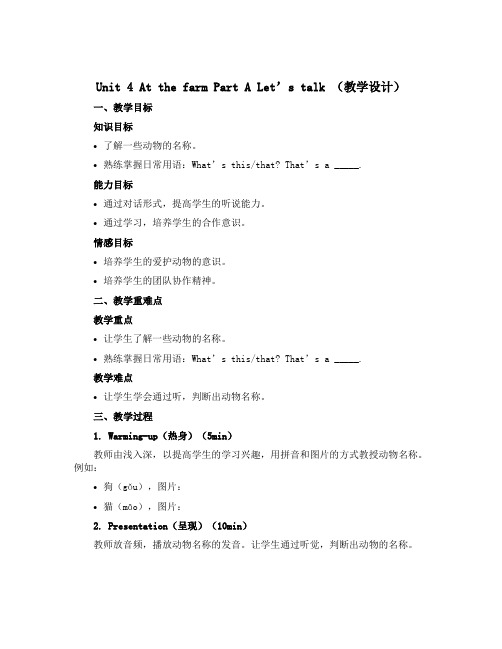
Unit 4 At the farm Part A Let’s talk (教学设计)一、教学目标知识目标•了解一些动物的名称。
•熟练掌握日常用语:What’s this/that? That’s a _____.能力目标•通过对话形式,提高学生的听说能力。
•通过学习,培养学生的合作意识。
情感目标•培养学生的爱护动物的意识。
•培养学生的团队协作精神。
二、教学重难点教学重点•让学生了解一些动物的名称。
•熟练掌握日常用语:What’s this/that? That’s a _____.教学难点•让学生学会通过听,判断出动物名称。
三、教学过程1. Warming-up(热身)(5min)教师由浅入深,以提高学生的学习兴趣,用拼音和图片的方式教授动物名称。
例如:•狗(gǒu),图片:•猫(māo),图片:2. Presentation(呈现)(10min)教师放音频,播放动物名称的发音。
让学生通过听觉,判断出动物的名称。
3. Practice(实践)(20min)教师把学生分为小组,在每组内让学生自由交流,用What’s this/that? That’s a _____的方式进行对话。
教师可以无时不在地操控学生,同时鼓励学生多说,提高合作意识。
4. Application(应用)(15min)学生通过为小组制作海报的形式,来确定学生的学习成果,同时鼓励小组之间互相交流,从而提高团队协作精神。
5. Conclusion(总结)(5min)教师和学生一起回顾本节课的教学重点和难点,并要求学生把今天掌握的知识点整理成笔记。
四、教学效果评价在以上教学的过程中,学生的学习兴趣得到了提高,同时学生的听说能力和团队协作精神也得到了提高,培养了学生的爱护动物意识和合作意识。
在小组制作海报的过程中,学生也能够对本节的知识点进行巩固,同时还能够感受到小组之间的融洽。
在教学效果评价的时候,教师要注意是否每一个学生都掌握了本节课的知识点,并能够熟练运用。
小学英语四年级下册《Unit4Atthefarm(PartALet'stalk)》说课稿

小学英语四年级下册《Unit 4 At the farm(Part ALet’s talk)》说课稿一. 教材分析《Unit 4 At the farm(Part A Let’s talk)》是人教版小学英语四年级下册的一篇课文。
本节课的主要内容是关于农场动物的介绍。
通过本节课的学习,学生能够掌握表示动物的单词,如cow, dog, cat, panda等,以及一般疑问句和回答。
同时,学生还能通过情景交际,运用所学知识进行简单的日常交流。
二. 学情分析四年级的学生已经具备了一定的英语基础,掌握了基本的单词和句型。
他们对英语学习充满兴趣,乐于参与课堂活动。
然而,部分学生在发音和听力方面还存在一定的困难,需要教师重点关注和指导。
三. 说教学目标1.知识目标:学生能够掌握表示农场动物的单词,如cow, dog, cat,panda等;能够理解并运用一般疑问句和回答进行交流。
2.能力目标:学生能够听懂并正确模仿单词和句子的发音;能够借助图片和情景,运用所学知识进行日常交流。
3.情感目标:培养学生热爱大自然,关爱动物的良好品质。
四. 说教学重难点1.重点:学生能够掌握表示农场动物的单词,如cow, dog, cat, panda等;能够理解并运用一般疑问句和回答进行交流。
2.难点:学生能够正确发音单词和句子,并在实际情景中运用所学知识进行交流。
五. 说教学方法与手段1.教学方法:采用情境教学法、交际法、任务型教学法等。
2.教学手段:利用多媒体课件、图片、实物等辅助教学。
六. 说教学过程1.热身(5分钟):教师与学生进行简单的英语对话,检查学生的英语水平。
然后,引导学生谈论他们喜欢的动物,激发学生的学习兴趣。
2.引入(10分钟):教师展示农场图片,引导学生说出他们认识的动物。
然后,教师出示本节课的生词卡片,带领学生一起学习新单词。
3.新课呈现(15分钟):教师播放课件,展示农场动物的视频,引导学生跟读并模仿发音。
Unit4Atthefarm(教案)人教PEP版英语四年级下册

教案:Unit4 At the farm教学内容:本节课为小学四年级下册英语人教PEP版Unit4 At the farm的内容,主要围绕农场生活展开,学习农场中常见的动物和农作物,以及相关的英语表达。
教学内容包括:1. 动物词汇:cow, pig, chicken, duck, horse, sheep2. 农作物词汇:corn, wheat, rice, vegetable3. 句型:What are these? They are教学目标:1. 知识目标:学生能够听懂、会说、会读本节课所学的动物和农作物词汇,并能运用句型进行问答。
2. 能力目标:学生能够在图片和实际情境中运用所学词汇和句型,进行简单的英语交流和表达。
3. 情感目标:培养学生对农场生活的兴趣和好奇心,激发学生英语学习的积极性。
教学难点:1. 动物和农作物词汇的发音和记忆。
2. 句型的正确运用和问答练习。
教具学具准备:1. 多媒体设备:用于展示图片和PPT。
2. 农场动物和农作物图片:用于教学和练习。
3. 学生练习册和课本。
教学过程:1. 导入:通过图片或视频展示农场生活,引起学生的兴趣和好奇心。
2. 新课内容呈现:通过PPT或图片展示本节课所学的动物和农作物词汇,引导学生跟读并模仿发音。
3. 句型练习:通过PPT或图片展示句型,引导学生进行问答练习,教师纠正发音和用法。
4. 小组活动:学生分组,每组选择一个农场动物或农作物,用所学句型进行介绍和问答。
板书设计:1. Unit4 At the farm2. 动物和农作物词汇列表。
3. 句型:What are these? They are作业设计:1. 学生练习册的相关练习题。
2. 家长辅助学生进行农场动物和农作物词汇的复习和巩固。
课后反思:本节课通过图片和实际情境的展示,激发了学生对农场生活的兴趣和好奇心,学生能够积极参与教学活动,并通过小组活动进行实际运用。
在教学中,教师应注重学生的发音和用法纠正,确保学生能够正确掌握所学知识。
Unit4-At-the-farm-教案教学设计
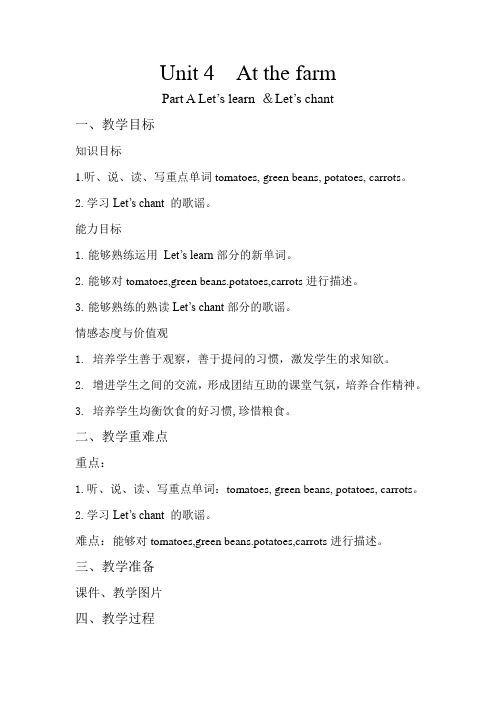
Unit 4 At the farmPart A Let’s learn &Let’s chant一、教学目标知识目标1.听、说、读、写重点单词tomatoes, green beans, potatoes, carrots。
2.学习Let’s chant 的歌谣。
能力目标1.能够熟练运用Let’s learn部分的新单词。
2.能够对tomatoes,green beans.potatoes,carrots进行描述。
3.能够熟练的熟读Let’s chant部分的歌谣。
情感态度与价值观1.培养学生善于观察,善于提问的习惯,激发学生的求知欲。
2.增进学生之间的交流,形成团结互助的课堂气氛,培养合作精神。
3.培养学生均衡饮食的好习惯,珍惜粮食。
二、教学重难点重点:1.听、说、读、写重点单词:tomatoes, green beans, potatoes, carrots。
2.学习Let’s chant 的歌谣。
难点:能够对tomatoes,green beans.potatoes,carrots进行描述。
三、教学准备课件、教学图片四、教学过程Step1 Warming up1.Greetings2.歌曲导入《Old Macdonald had a farm》,板书课题《At the farm》Step2 Presentation &Practise1.出示西红柿图片,问学生“What’s this?”引出单词,教学单词并板书,领读,注意升降掉。
2.课件展示三个西红柿,引出西红柿的复数形式tomatoes,用红色标注es,领读。
3.同样的方法导入green beans,potatoes,carrots。
板书并注明复数形式。
4.出示练习,填单词完成句子,让学生正确区别名词的单复数形式。
5.全班做“What’s this?”的游戏,进一步巩固单词。
教师拿出准备好的蔬菜图片,学生连续击掌,边击掌边说:What's this?What's this?当教师停在某位学生身边时,全班学生立刻停止发问,该名学生必须迅速站起来说出这个蔬菜的名称,以及它的复数形式。
小学的英语人教PEP四年级的下册Unit+4+At+the+farm+Part+A+教案4

小学英语人教 PEP四年级下册Unit 4 At the farm Part A教课设计一、教课目的:1 知识目标:听闻认读 A 部分的 let ’ s learn; let’ s chant2 能力目标:能够听闻认读农场中常有的蔬菜:tomato, cucumber, potato, onion, carrot能够运用一些形容词,描绘蔬菜的特点,如:big, fresh 等能够演唱韵文,表达自己喜爱或不喜爱的蔬菜3 感情目标:激发学生学习英语兴趣,认识农场的一些知识。
培育学生热爱大自然的质量并懂得珍惜农民的勤劳奋动成就。
二、教课要点:掌握农场上常有的蔬菜名称三、教课难点: potato, tomato 的复数形式四、教课过程:1热身环节:经过播放韵文《小土豆》,引出本课话题vegetables2体现环节:(1)体现单词:主要以摸、猜的形式来体现如:摸 ---将蔬菜的实物放入到一个口袋中,让学生用手触摸并猜出蔬菜的名称猜 ---体现以蔬菜做出的各样动物造型的图片来引出本课单词(2)体现句型:教师能够利用实物,为学生创建情境,进行描绘蔬菜如:取出西红柿,土豆,第一步:以单数形式体现tomato, potato第二步:以复数形式体现tomatoes, potatoes ,让学生察看单复数变化形式的不一样,解决本课难点第三步:教师示范描绘这两样蔬菜西红柿: They are fresh. They are red and round.土豆:They are tasty. They are brown.3演练环节:(1)单词演练:听单词拍图片,小组里保证有一些本课单词的图片第一步:教师说,学生听到哪个词就拍相应的图片,同时要陪伴语言,随着老师重复单词(示范这个游戏的做法)第二步:学生在小组里,由组长带着做这个游戏,给学生一些自主的空间,在他们体验在完中学的乐趣(2)句型演练:a学生将自己所带的蔬菜取出来,像好朋友介绍它们的颜色、特点b利用 B 部分的韵文稳固句型4运用环节:教师为学生创建情境并提出任务:和你的好朋友一同去农场的菜园观光,并为家里买一些蔬菜回来。
PEP小学英语四年级(下)Unit 4 At the farm Part A Let’s talk教学设计及教后反思word精品文档7页

PEP小学英语四年级(下)Unit 4 At the farm Part A Let’stalk教学设计及教后反思一、教材分析本课是人民教育出版社PEP小学英语四年级下册第四单元Part A Let’s talk的教学设计。
二、教学目标:(一)知识与能力。
1.借助多媒体,帮助学生正确理解本课的对话大意。
2.培养学生用正确的语音、语调朗读对话,并能进行角色表演。
3.在情景中恰当运用所学句型进行简单的问答练习:Are these ...? Yes,they are./No, t hey aren’t. What are these?They’re .....4.培养学生的口头表达能力和表演能力。
(二)过程与方法。
多给学生创造说的机会,让他们在不断的练习中巩固新知识。
首先通过边唱歌曲边做动作活跃课堂气氛,为新知呈现做好铺垫。
导入新课时以邀请学生到老师的农场参观为主线,以旧知识带出新知识,之后通过多种形式的读、说进行重点句型的操练及对话配乐、对话扮演、对话创编。
逐步掌握了本课的重难点,既提高了课堂效率又培养了学生的兴趣。
(三)情感、态度与价值观。
1.教育学生要以得体的方式与人交际。
2.教育学生从小养成多吃蔬菜、水果的好习惯。
三、教学重点:1.在情景中运用所学句型问答:Are these... ? Yes, they are. No,they aren’t. What are these?They’re ....2.掌握名词复数形式的特殊疑问句和一般疑问句用法,并能用相应的句子进行问答:What are these?They’re.... Are these...?Yes, they are./ No, theyaren’t.四、教学难点:1.培养学生在情景中运用所学句型,提高交际能力。
2.理解名词单复数的意义以及相应句型的变化,并能在情景中正确运用和表达。
教具准备:头饰、草帽、水果和蔬菜实物、多媒体课件、图片。
人教PEP版英语四年级下册Unit 4《At the farmt》(story time)教案

人教PEP版英语四年级下册Unit 4《At the farmt》(story time)教案一. 教材分析《At the farm》是人教PEP版英语四年级下册Unit 4的故事时间部分,主要讲述了Mike、Mum和Mary去农场的故事。
通过参观农场,他们看到了许多动物和植物,并学习了有关农场动物和植物的英语词汇。
本故事内容丰富,插图生动有趣,能够激发学生的学习兴趣,提高他们的英语水平。
二. 学情分析四年级的学生已经掌握了基本的英语发音和单词,具备了一定的听说读写能力。
他们对新鲜事物充满好奇,善于模仿和探究。
因此,在教学过程中,教师应充分利用学生的这些特点,创设有趣的情境,让他们在轻松愉快的氛围中学习英语。
三. 教学目标1.知识目标:学生能够听懂、会说、会读本故事中的词汇和句子,如cat, dog, cow, horse, pig, hen, farm, farm动物等。
2.能力目标:学生能够运用所学词汇和句型介绍农场中的动物和植物,提高他们的语言表达能力。
3.情感目标:培养学生热爱大自然、关爱动物的情感。
四. 教学重难点1.重点:学生能够听懂、会说、会读本故事中的词汇和句子。
2.难点:学生能够运用所学词汇和句型介绍农场中的动物和植物。
五. 教学方法1.情境教学法:通过创设有趣的农场情境,激发学生的学习兴趣。
2.游戏教学法:运用游戏活动,让学生在轻松愉快的氛围中学习英语。
3.任务型教学法:引导学生参与各种任务,提高他们的语言实践能力。
六. 教学准备1.教学课件:制作课件,包括故事内容、图片、动画等。
2.农场道具:准备一些农场动物和植物的道具,如玩具动物、图片等。
3.教学音频:准备本故事的相关音频资料,以便学生跟读和模仿。
七. 教学过程1.导入(5分钟)利用课件展示农场图片,引导学生谈论农场,为新课学习营造氛围。
2.呈现(10分钟)播放故事动画,让学生初步感知故事内容。
随后,教师引导学生跟读故事,注意模仿语音语调。
Unit 4 At the farm Part A Let's talk(教案)英语四年级下册
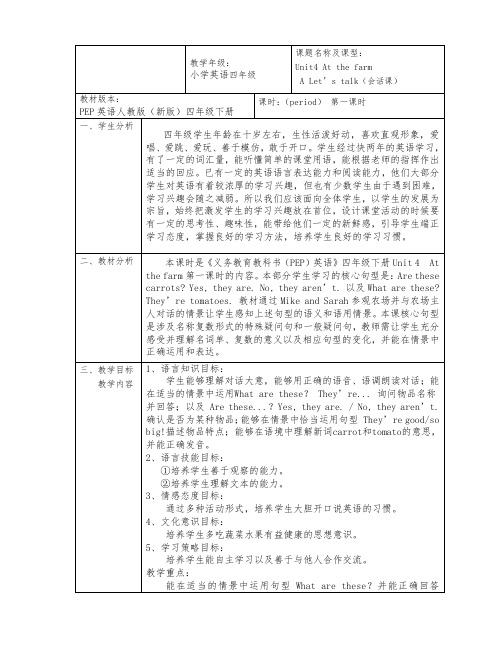
So...对所见物品进行描述。
T: What is this?S: It’s an apple.( a watermelon)T: Look! What are these?S: They’re apples.(watermelons)T: They’re ... ( red/green/big/good...)设计意图: 通过情景问答激活学生的已有图式,并强调对单数物品的表达,引入复数物品的问答,再结合情景物品帮助学生复习对物品特点的描述,为下面复数物品的表达的学习做铺垫。
(三)Presentation1、解决单词tomato的音、义及其复数形式的变化和学习问答句—What are these?—They’re...从上一环节自然引入tomato 的学习。
T: What is this?S: It’s a tomato.师出示单词卡`带读tomato,并请同学读,通过Phonics帮助学生掌握tomato的两种发音。
并通过tomato数量的变化学习tomato的复数形式,通过出示实物强调问答句—What are these?—They’re tomatoes. 板书并教学朗读。
T: Look! What are these?S: They’re tomatoes.设计意图: 通过课件创设语境引出新词tomato及其复数形式的学习,再利用西红柿实物解决本课的重点问答句—What are these?—They’re...2、(Task 3) Look and guess:让学生猜所见到的蔬果。
一猜carrot,解决单词carrot的音、义及其复数形式的变化和学习问答句—Are these...?—Yes ,they are./ No, they aren’t.并板书朗读。
T: Look! What are these? You can use “Are these...?”to guess. S: Are these carrots?通过单词卡与胡萝卜实物教学carrot单词的单复数。
PEP小学英语四年级下册教案Unit4--At-the-farm-A-Let's-learn
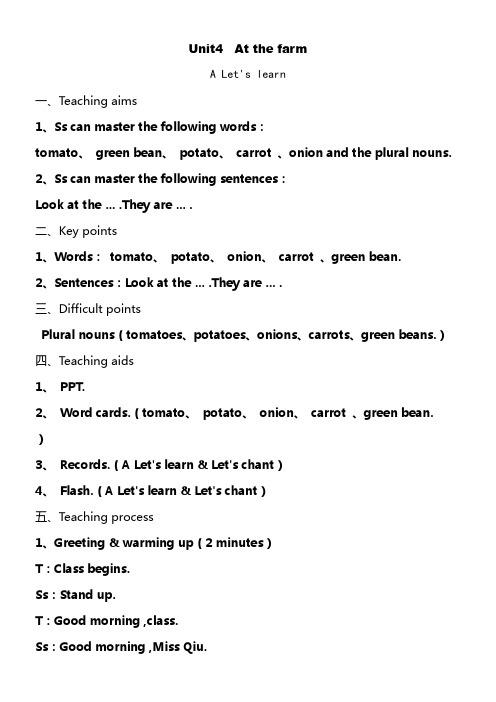
Unit4 At the farmA Let's learn一、Teaching aims1、Ss can master the following words:tomato、green bean、potato、carrot 、onion and the plural nouns.2、Ss can master the following sentences:Look at the ... .They are ... .二、Key points1、Words:tomato、potato、onion、carrot 、green bean.2、Sentences:Look at the ... .They are ... .三、Difficult pointsPlural nouns(tomatoes、potatoes、onions、carrots、green beans.)四、Teaching aids1、PPT.2、Word cards.(tomato、potato、onion、carrot 、green bean.)3、Records.(A Let's learn & Let's chant)4、Flash.(A Let's learn & Let's chant)五、Teaching process1、Greeting & warming up(2 minutes)T:Class begins.Ss:Stand up.T:Good morning ,class.Ss:Good morning ,Miss Qiu.T:How are you today?Ss:I'm fine ,thank you.And you?T:Very well ,thanks.Are you ready for our English class?Ss:Yes.T:Great.Sit down ,please.Ss:Thank you.2、Lead in(2 minutes)Enjoy a chant.T:Boys and girls,look at the pc screen.Let's enjoy a chant.I like tomatoes.I like potatoes.Carrots I will try.I love to eat green beans.But onions make me cry.3、presentation(16 minutes)(1)TomatoT:Wow!There are so many vegetables in this chant.The first one is tomato.Read after me. Tomato, to-ma-to tomato,tomato↗↘,tomato↗↘,tomato↗↘.Ss:Tomato,to-ma-to tomato,tomato↗↘,tomato↗↘,tomato↗↘.T:Group by group.Are you ready?Ss:Yes.T:Group1、2、...5,tomato.Group1、2、...5:tomato.T:Good,nice,great,wonderful,excellent.Together. Ss:Tomato.T:Wow,wow,wonderful.Ss:Wow,wow,wonderful.T:(Take out a tomato.)Look,What's this?Ss:It's a tomato.T:(Take out 2 tomatoes.)Look,What's these?Ss:They are tomatoes.T:You are so clever.Read after me.Look at the tomatoes.Ss:Look at the tomatoes.T:What color are they?Ss:Red.T:Look at the tomatoes.They are red.Ss:Look at the tomatoes.They are red.T:Who can try?You please.S1:Look at the tomatoes.They are red.T:Good.You please.S2:T:Look at the tomatoes.They are red.T:Wonderful....T:Together.Ss:Look at the tomatoes.They are red.T:Wow,wow,wonderful.Ss:Wow,wow,wonderful.(2)PotatoT:The second one is potato.Read after me. Potato, po-ta-to potato,potato↗↘,potato↗↘,potato↗↘.Ss:Potato, po-ta-to potato,potato↗↘,potato↗↘,potato↗↘.T:Group by group.Are you ready?Ss:Yes.T:Group1、2、...5,potato.Group1、2、...5:potato.T:Good,nice,great,wonderful,excellent.Together.Ss:Potato.T:Wow,wow,wonderful.Ss:Wow,wow,wonderful.T:(Take out a potato.)Look,What's this?Ss:It's a potato.T:(Take out 2 potatoes.)Look,What's these?Ss:They are potatoes.T:You are so clever.Read after me.Look at the potatoes.Ss:Look at the potatoes.T:What color are they?Ss:Brown.T:Look at the potatoes.They are brown.Ss:Look at the potatoes.They are brown.T:Who can try?You please.S1:Look at the potatoes.They are brown.T:Good.You please.S2:Look at the potatoes.They are brown.T:Wonderful....T:Together.Ss:Look at the potatoes.They are brown.T:Wow,wow,wonderful.Ss:Wow,wow,wonderful.(3)CarrotT:The third one is carrot.Read after me. Carrot, ca-rrot,carrot,carrot↗↘,carrot↗↘,carrot↗↘. Ss:Carrot, ca-rrot,carrot,carrot↗↘,carrot↗↘,carrot↗↘.T:Group by group.Are you ready?Ss:Yes.T:Group1、2、...5,carrot.Group1、2、...5:carrot.T:Good,nice,great,wonderful,excellent.Together.Ss:Carrot.T:Wow,wow,wonderful.Ss:Wow,wow,wonderful.T:(Take out a carrot.)Look,What's this?Ss:It's a carrot.T:(Take out 2 carrots.)Look,What's these?Ss:They are carrots.T:You are so clever.Read after me.Look at the carrots.Ss:Look at the carrots.T:What color are they?Ss:Orange.T:Look at the carrots.They are orange.Ss:Look at the carrots.They are orange.T:Who can try?You please.S1:Look at the carrots.They are orange.T:Good.You please.S2:Look at the carrots.They are orange.T:Wonderful....T:Together.Ss:Look at the carrots.They are orange.T:Wow,wow,wonderful.Ss:Wow,wow,wonderful.(4)Green beanT:The fourth one is green bean.Read after me. Green bean, green bean,green bean↗↘,greenbean↗↘,green bean↗↘.Ss:Green bean, green bean,green bean↗↘,green bean↗↘,green bean↗↘.T:Group by group.Are you ready?Ss:Yes.T:Group1、2、...5,green bean.Group1、2、...5:green bean.T:Good,nice,great,wonderful,excellent.Together.Ss:Green bean.T:Wow,wow,wonderful.Ss:Wow,wow,wonderful.T:(Take out a green bean.)Look,What's this?Ss:It's a green bean.T:(Take out 2 green beans.)Look,What's these?Ss:They are green beans.T:You are so clever.Read after me.Look at the green beans.Ss:Look at the green beans.T:What color are they?Ss:Green.T:Look at the green beans.They are green.Ss:Look at the green beans.They are green.T:Who can try?You please.S1:Look at the green beans.They are green.T:Good.You please.S2:Look at the green beans.They are green.T:Wonderful....T:Together.Ss:Look at the green beans.They are green.T:Wow,wow,wonderful.Ss:Wow,wow,wonderful.(5)OnionT:The last one is onion.Read after me. Onion, o-nion,onion,onion↗↘,onion↗↘,onion↗↘. Ss:Onion, o-nion,onion,onion↗↘,onion↗↘,onion↗↘.T:Group by group.Are you ready?Ss:Yes.T:Group1、2、...5,onion.Group1、2、...5:onion.T:Good,nice,great,wonderful,excellent.Together.Ss:Onion.T:Wow,wow,wonderful.Ss:Wow,wow,wonderful.T:(Take out a onion.)Look,What's this?Ss:It's a onion.T:(Take out 2 onions.)Look,What's these?Ss:They are onions.T:You are so clever.Read after me.Look at the onions.Ss:Look at the onions.T:What color are they?Ss:Purple.T:Look at the onions.They are purple.Ss:Look at the onions.They are purple.T:Who can try?You please.S1:Look at the onions.They are purple.T:Good.You please.S2:Look at the onions.They are purple.T:Wonderful....T:Together.Ss:Look at the onions.They are purple.T:Wow,wow,wonderful.Ss:Wow,wow,wonderful.4、ConsolidationT:Boys and girls,look at the pc screen,Let's read the chant together. Ss:Look at the tomatoes.They are red.Look at the potatoes.They are brown.Look at the carrots.They are orange.Look at the green beans.They are green.Look at the onions.They are purple.T:Wow,wow,wonderful.Ss:Wow,wow,wonderful.T:Boys and girls,look at the pc screen.Listen and look A Let's learn. T:Now,read after the tape.Ss:...T:Boys and girls,open your English book and turn to page 39.Now read after me. ...Ss:...T:OK.You read the words and sentences together.Ss:...T:Wow,wow,wonderful.Ss:Wow,wow,wonderful.T:Boys and girls,look at the pc screen.There are 5 vegetables.I'd like divide you into groups.Each group has 4 e the sentences and describe 2 of the vegetables.I'll give you 2minutes.Let's go.T:Boys and girls,time's up.Are you ready?Ss:Yes.T:You please.G1:...T:Good.You please.G2:...T:Wonderful.You please....六、Homewore1、Copy the new words and sentences 4 times.2、Listen and read A Let's talk and Let's chant.七、Blackboard designUnit 4 At the farmA Let's learnLook at the tomatoes.They are red.Look at the potatoes.They are brown.Look at the carrots.They are orange.Look at the green beans.They are green.Look at the onions.They are purple.八、Teaching reflectionI think I should pay more attention to the plural nouns.。
人教PEP四年级下册英语Unit 4 At the farm 教案

Unit 4 At the farm第一课时一、教学内容Part A Let’s talk &Let’s play二、教学目标1.能正确听说句子What are these? Are these...? 并能根据实际情况进行回答。
2.正确理解与朗读对话内容,并正确表达水果和蔬菜的名称和特点。
3. 能够听说、认、读单词tomato和carrot。
三、教学重难点1. 能熟练掌握句型What are these? They are… Are these/they…? Yes/No.2. 掌握these的发音,理解这个单词的用法。
四、教学准备教学课件、录音机、磁带、简笔画五、教学过程Step 1 热身(Warming-up)1. 教师拿出一个苹果(或卡片)提问:What’s this? 学生用所学知识回答:It’s an apple. 教师继续提问:Is it an apple? 学生做肯定回答。
2. 让学生回忆询问单数物体名称的特殊疑问句和一般疑问句。
教师展示带有多个苹果的卡片,教师提问:What are they?引导学生答:They are apples. 让学生从单数概念进入到复数概念,为新课做好铺垫。
Step 2 新课呈现(Presentation)1. 学习Let’s talk(1)教师用课件出示一张有多个胡萝卜的图片,提问:Are they apples? 提示回答:No, they aren’t. 继续提问:What are they? 导出:They are carrots. 用相同方法导出tomatoes。
教师领读tomato和carrot, 重复提问和回答,练习句型和新单词:T: What are they?S: They are…T: Are they…?S: Yes, they are. /No, they aren’t.(2) 教师播放录音,让学生跟读并模仿。
指导学生注意try, some的读音,并试着翻译。
四年级英语下册教学设计《Unit4AtthefarmPartBLet’slearn》人教PEP版

四年级英语下册教学设计《Unit 4 At the farm Part B Let’s learn》人教PEP版一. 教材分析《Unit 4 At the farm Part B Let’s learn》是人教PEP版四年级英语下册的一篇课文。
本课主要介绍了农场动物的名称和特征。
内容包括: cows, pigs, sheeps,hens, monkeys, penguins等动物的图片及描述。
通过本课的学习,学生能够掌握动物的名称和特征,提高他们的观察力和表达能力。
二. 学情分析四年级的学生已经掌握了基本的英语语法和词汇,具备一定的听、说、读、写能力。
他们对动物充满好奇,喜欢观察和描述动物的特点。
然而,部分学生可能在发音和词汇方面存在困难,需要教师的耐心指导。
三. 教学目标1.知识目标:学生能够听懂、说出一系列动物的名称和特征。
2.能力目标:学生能够用英语描述动物的特点,提高他们的观察力和表达能力。
3.情感目标:培养学生对动物的关爱和保护意识。
四. 教学重难点1.重点:动物的名称和特征。
2.难点:动物名称的准确发音和词汇的运用。
五. 教学方法采用情景教学法、互动式教学法和任务型教学法。
通过设置农场情境,引导学生观察、描述动物的特点,激发学生的学习兴趣,提高他们的参与度和积极性。
六. 教学准备1.准备动物的图片和描述。
2.准备农场场景的图片或视频。
3.准备录音机或音响设备。
七. 教学过程1.导入(5分钟)利用图片或视频展示农场场景,引导学生观察并提问:“Can you see any animals on the farm?”,激发学生的学习兴趣。
2.呈现(10分钟)展示动物的图片和描述,引导学生说出动物的名称和特征。
如:“This is a cow. It has a long tl and four legs.”,引导学生跟读并模仿动物的特征。
3.操练(10分钟)分组进行角色扮演,让学生模拟农场场景,互相描述动物的特点。
小学四年级下册unit4 At the farm英语教案
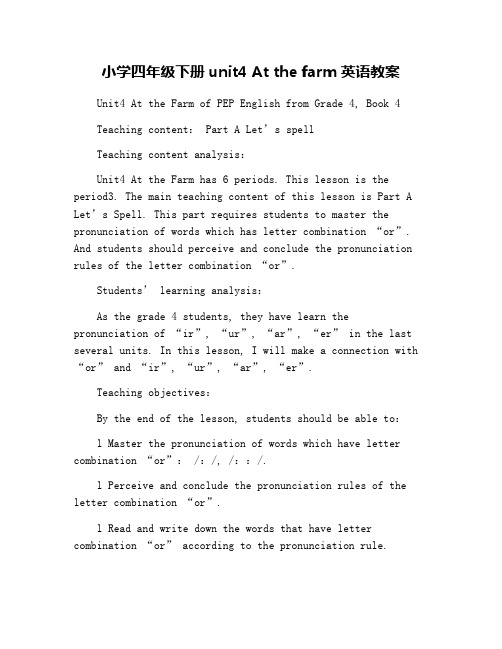
小学四年级下册unit4 At the farm英语教案Unit4 At the Farm of PEP English from Grade 4, Book 4Teaching content:Part A Let’s spellTeaching content analysis:Unit4 At the Farm has 6 periods. This lesson is the period3. The main teaching content of this lesson is Part A Let’s Spell. This part requires students to master the pronunciation of words which has letter combination “or”. And students should perceive and conclude the pronunciation rules of the letter combination “or”.Students’ learning analysis:As the grade 4 students, they have learn the pronunciation of “ir”, “ur”, “ar”, “er” in the last several units. In this lesson, I will make a connection with “or” and “ir”, “ur”, “ar”, “er”.Teaching objectives:By the end of the lesson, students should be able to:l Master the pronunciation of words which have letter combination “or”: /:/, /::/.l Perceive and conclude the pronunciation rules of the letter combination “or”.l Read and write down the words that have letter combination “or” according to the pronunciation rule.l By the learning of pronunciation can make the students notice the fixed pronunciation of some letter combinations, which can improve students speech recognition ability and reading ability.Important and difficult points of teaching:Make the students to master the pronunciation of words which have letter combination “or”. And make them to perceive and conclude the pronunciation rules of the letter combination “or”.Teaching process:I Warm-up1. Free talk.T: Good morning, boys and girls.Ss: Good morning, Miss Yang.T:Today we’ll learn Unit 4 At the Farm PartA Let’s spell.2. T:Before our class, let’s enjoy two chants.(Teacher plays the chants about the pronunciation of “ir”, “ur” and “al”, which they have learned before.)3. Teacher shows the words which contain “ir”, “ur” and “al” to recall the knowledge they have learnt.4. Teacher asks students whether they remember the pronunciation of “ir”, “ur”, “ar”, “er”. And then teacher can naturally introduce “or” to students.[Design idea:Recall the knowledge they have learned. Use “ir” and “ur”, which pronounce /:/, and “al”, which pronounces /::/, to make connection with “or”.]II Presentation1 . Presentation “or”: /:/⑴Teacher shows 3 words, which are work, homework, world map, and asks students to read it.⑵Teacher asks students to discuss the pronunciation rule of “or”.[Design idea:Let students perceive and conclude the pronunciation rules of the letter combination “or”. ]⑶Teacher presents the pronunciation rule 1 of “or”:or在w后通常发/:/,与ir,ur同音.⑷Teacher shows the words: word, worth, worm, worse. And then requires students to spell them according to the pronunciation rule 1.[Design idea:make students be able to read the wordsthat has letter combination “or” according to the pronunciation rule 1.]2 . Presentation “or”: /::/⑴Teacher shows students the word “horse” and ask thema question that whether this word pronounce /h:s/.⑵Teacher asks students to find out the pronunciation of the word “horse” and pay attention to the other words that has “or” in a chant.Chant: The story about a horseI like to read the story.The story about the horse.The horse likes to work.He works hard of course.⑶After listening to the chant, teacher asks students to read the words: horse, story.⑷Teacher shows 4 words, which are horse, fork, story, morning, and asks students to read it.⑸Teacher asks students to conclude the pronunciation rule of “or”.⑹Teacher presents the pronunciation rule 2 of “or”:or在单词中一般发/::/,与al 同音.⑺Teacher asks students to make brainstorm about the words that contain “or” that pronounce /::/.3. SummaryTeacher asks students to summary the pronunciation of “or”:发音规则1:or在w后通常发/:/,与ir,ur同音发音规则2:or在单词中一般发/::/,与al 同音III Practice1. Listen and number[Design idea:First of all teacher will help students to master the pronunciation of words which has letter combination “or”: / :/, /::/ by listening.]2. Read and sort[Design idea:Secondly, through speaking, teacher helps students to be able to read the words that has letter combination “or” according to the pronunciation rule.]3. Look. Listen and writeTeacher asks students to write down the important words.[Design idea:Thirdly, though writing, teacher helps students to be able to write down the words that has letter combination “or” according to the pronunciation rule.]IV ProductionTeacher make a summary with students that the pronunciation of “or”,“ir”, “ur”, “ar”, “er”. And then teacher will guide students to be aware that the fixed pronunciation of some letter combinations.V Homework记住or的发音规则,并尽量查找单词来练习or的发音。
- 1、下载文档前请自行甄别文档内容的完整性,平台不提供额外的编辑、内容补充、找答案等附加服务。
- 2、"仅部分预览"的文档,不可在线预览部分如存在完整性等问题,可反馈申请退款(可完整预览的文档不适用该条件!)。
- 3、如文档侵犯您的权益,请联系客服反馈,我们会尽快为您处理(人工客服工作时间:9:00-18:30)。
5.出示蔬菜的图片,反复问不同学生“What are these?”,学生回答“They are ...”。
6.教师指着另一张蔬菜的图片问学生“Are these tomatoes?”,学生回答“Yes, they are./No, they aren't.”。
A. They are good!B. It's good!
Answer: 1.A2.B3.A4.A5.A
Step 6:Homework(作业)
1.听录音并朗读对话3遍。
2.做本课时的对应练习。3.预Part ALet's learn。
板书设计
Unit 4At the farm
Part ALet's talkLet's play
2.教师出示食物和水果的图片,进行师生互动。例如:
T: What's this?
Ss: It's a(n) ...
T: Is it a(n) ...?
Ss: Yes, it is./No, it isn't.
复习前面学过的有关食物和水果名称的单词,为引出本节课话题做准备。
Step 2:Presentation&Practice(新课呈现&当堂操练)
Unit 4At the farm
Part ALet's talkLet's play
教学导航
一、教学目标
1.能够听、说、认读单词these、yum、tomato和carrot。
2.能正确理解与朗读对话内容,并能正确表达水果和蔬菜的名称和特点。
3.能正确听说句子“What are these?”“Are these ...?”,并能根据实际情况进行回答。
3.教师出示两个西红柿实物并询问“Look at these! What are these?”,引导学生回答“They are tomatoes.”,并板书带读。然后教师问“Do you want to try some?”,学生回答“Yes.”,教师板书try some并带读。接着把西红柿切成若干块给学生尝尝。最后教师问“What's your feeling?”。(学生谈谈自己的口感)并引出单词yum。
7.教师展示Mike图片说“Today, Mike is at a farm. Let's go and have a look.”。
播放课本动画,学生看动画回答:
They are talking about the________.(vegetables)
8.学生打开课本,自学并完成以下两题:
The carrots are ________.A. smallB. big
2.不足之处:尽管教师重点强调tomato变复数的形式,有个别同学还是会出现错误。
3.教学建议:重点强调课上纪律,让学生课上认真听讲。针对个别学生出现错误,有针对性地提问回答。
二、教学重点、难点
掌握句型“What are these?”“They are ...”“Are these/they ...?”“Yes/No.”。
三、教学准备
单词卡片、教学光盘和多媒体课件。
教学过程
Step 1:Review&Lead in(复习&导入)
1.播放歌曲“An apple a day”,学生齐唱歌曲。
—What are these? —They are tomatoes/carrots/ ...
—Are these ...? —Yes, they are./No, they aren't.
Try some! They are good.
教学反思
1.亮点:本节课教师通过一个西红柿、一个胡萝卜实物引出句子“What's this?”,用两个西红柿、两个胡萝卜引出“What are these?”“Are these ...?”这两个重点句型,并且形成鲜明的对比,给学生留下深刻的印象。
The tomatoes are________.A. yellowB. red
9.教师播放课本录音,学生跟读,然后分小组展示。
Step 3:Consolidation&Extension(巩固&拓展)
1.学生三人一组分角色朗读表演对话,然后全班展示。
2. “猜一猜”游戏。
出示Let's play部分的图片。教师请三个学生示范:
()3.你想让朋友“尝试一些”,应该这样说:________
A. Try some.B. They're good.
()4.你想询问“这些是什么”,应该这样问:________
A. What are these?B. Look at these.
()5.你想表达“他们很棒”,应该这样说:________
S1: What are these?
S2: Are they tomatoes?
S3: No.
...
学生三人一组开展游戏,然后全班展示。
Step 4:Summary(小结)
本课我们重点学习了用句型“What are these?”“They're ...”问答物品名称,运用句型“Are these ...?”“Yes, they are./No, they aren't.”确认是否为某种物品。
1.教师出示一个西红柿、一个胡萝卜实物,询问学生“What's this?”,引导学生回答“It's a tomato/carrot.”,并板书带读。
2.教师出示两个胡萝卜实物,问学生“What are these?Are these tomatoes?”,学生回答“No.”。教师肯定学生的回答“Good. These are carrots. They're so big.”,教读单词carrots,强调其复数形式,并板书,让学生认读。
Step 5:Test(当堂微测)
情景选择。
()1.你想询问“这些是胡萝卜吗”,应该这样问:________
A. Are these carrots?B. Are they carrots?
()2.你想表达“它们这么大”,应该这样说:________
A. They're big!B. They're so big!
